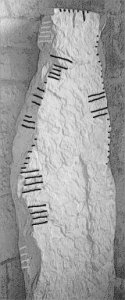According to Brash, JRSAI 10, 1869, 260, the stone was found in a structure called Rath Lisheenagreine, in the townland of Gurranes (sic!), parish of Templemartin, 1 mle. north of the parish church (the village in question is named "Gurranes" in the Cork U.C. too). A detailed map of the rath (in connection with the larger Rath Lisnacaheragh) is available in S.P. O' R¡ordÿin's article in PRIA 47-C, 1941-42, 77 ff. - According to Brash, the stone was discovered by one farmer Crowley 17 years before (the publication of his article in JRSAI 10, 1869); Macalister states in CIIC that it "has been known since the sixities" and "appears to have come from a souterrain in the group" of "earth-works" on the townland of Gurranes. The first report was made by John Lyons, C.C., Newcestown, Enniskeane; Brash's visit took place on 16.12.1868.
The stone was moved to the Museum of the U.C., Cork after Macalister first visited it (at that time it was still "standing loosely in one of the ditches": CIIC 1, 84). In the collection of the U.C., it is assigned no. 17.
Size according to Macalister, CIIC: 5'9" x 1'7" x 0'7"
Published illustrations:
- Brash, OIM pl. V fig. (3) (draft);
- Macalister, CIIC 1, 83 (draft).
CASSITTAS MAQI MUCOI CALLITI
"Cassitt as Maqi Mucoi Calliti"
"Cassit here, the son of the Swineherd Calliti."
The A in CASSITI is "lost". - For the name cp. Cormac Cas AD 170 or Caisin, scribe of Lusca, d. AD 695 (Annals Four Masters). The word final AS is "warranted" by several other inscriptions. MUCOI means literally "swineherd"; cp. mucaidhe in Gaelic dictionaries. [Some informations about pig keeping follow.] CALLITI is not identifiable; might this be a form of "Cailte"? - The same "form" is present in an inscription from Aghaliskey {70: Ahalisky}, cf. JRSAI 10, 1869, 439.
CASSITTAS MAQI MUCOI CALLITI
Tentatively ("?") this could be connected with the tribal name of the Calraige.
C[A]SSITT[A]S MAQI MUCOI CALLITI
1I is written like AUA. - [It is by no means clear whether the photograph printed in CIIC 1, 84 shows this stone.]
C[A]SSITT[O]S MAQI MUCOI CALLITI
The restitution of -TOS is more probable than Macalister's -T[A]S. The inscription belongs to the early period, before the middle of the 5th century. - [p. 127:] CASSITTOS is a "hypocoristic formation from a base *kass-, i.e. *Kass-itti-s (nom.). - [p. 125:] CALLITI is the gen. of *kalitas, *kallitas, *kalittas or *kaillitas etc. The name is hard to interpret: does it belong to O.Ir. caill "wood" with the hypocoristic suffix -itto- / *-ittjo- or to calad, archaic caleth "hard, severe" < *kaletos, with a different suffix? Then cp. the Gaul. tribal name Caleti meaning "the hard ones". Furtheron cp. the Irish tribal name Cal-raige [the same suggestion was made by McNeill before] and the PNs Cailit¡n, Calat¡n from the legends. If A represents a diphthong, it could belong to Ca¡lte <*Kailitjas (Ossian), this reflecting the nom. of CALLITI. Further cp. the Gaul. PNs Callus, Callis, Calla, Callavus .. "(AS)".
CaSSITTa/oS MAQI MUcoI CALLITI
Reading Gippert (1981):
 Dexter angle up - top - sinister angle down:
Dexter angle up - top - sinister angle down:
(C)[A]SSI[O]TTAS M(AQ)|I M(UC|O)I CALLITI
(îì)[â]êèêèåä(ã]ííâêèï(âîí)|åäï(äîì|ã)åäîìâèèåäíåä
(ëëëë)[â]ççççæççççâââââ(â)âëëëæëëëâççççï(âëëëëë)|âââââïâ(ââëëëë|ââ)âââââëëëëâççæççâââââëëëâââââ
After SS, all in all seven vowel notches are recognizable the sixth of which could even represent a ç B. - There are hardly any traces visible of Macalister's 1A and 2A. - Regarding the names, we have to consider that the rath nearby, named Rath Lisnacaheragh, has to be identified with Rÿth Raithliu, the see of the Eoganachta / U¡ Eachach, cf. O'R¡ordÿin, PRIA 47/C, 1941-42, 77ff. and Rev. John Ryan (ib. 145 ff.: Historical Addendum). According to these authors, an "important dynast" of the "Eoganachta occupation of the area along the Bandon river" was Eochu, son of Mac CAS, son of Corc, king of Cashel (thus according to Rawl. B 502, 149a, 150a; ib. 145 Anm. 3). Mac CAS himself "is a shadowy personage"; he was connected with the Dÿl Chais (with Cormac CAS as their "remote ancestor") and thus with the Eogannachta. Further we have to consider the Clanna Chais mentioned in the Book of Rights (ib. 149 sq.). Although the two Ls in CALLITI seem to be well separated, we might think of reading CASITI instead.
Additional literature:
- Ivernian 3, 1911, 73 (Henebry).
- JCHAS 26, 1931, 67.
Last changes of this record: 26.04.97
Copyright Jost Gippert, Frankfurt a/M 1996. No parts of this document may be republished in any form without prior permission by the copyright holder.  Dexter angle up - top - sinister angle down:
Dexter angle up - top - sinister angle down: